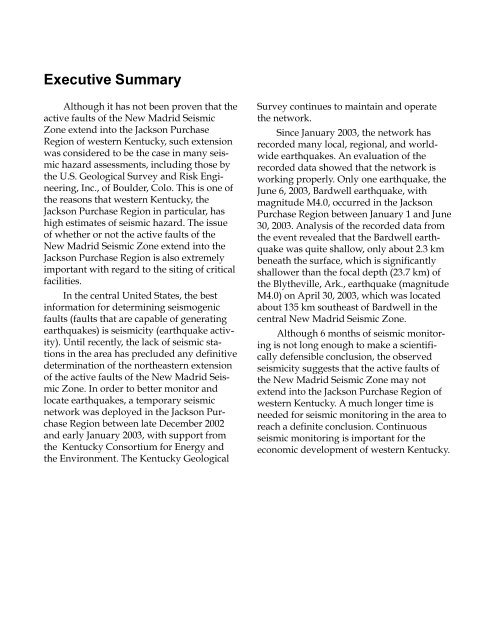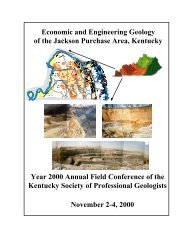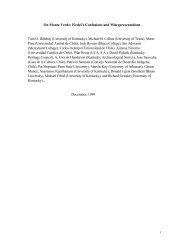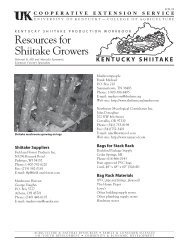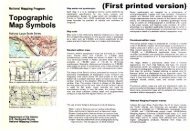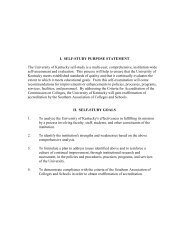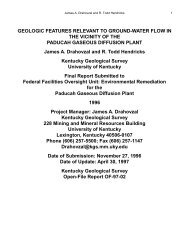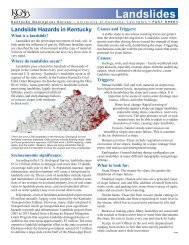Observed Seismicity - University of Kentucky
Observed Seismicity - University of Kentucky
Observed Seismicity - University of Kentucky
You also want an ePaper? Increase the reach of your titles
YUMPU automatically turns print PDFs into web optimized ePapers that Google loves.
Executive Summary<br />
Although it has not been proven that the<br />
active faults <strong>of</strong> the New Madrid Seismic<br />
Zone extend into the Jackson Purchase<br />
Region <strong>of</strong> western <strong>Kentucky</strong>, such extension<br />
was considered to be the case in many seismic<br />
hazard assessments, including those by<br />
the U.S. Geological Survey and Risk Engineering,<br />
Inc., <strong>of</strong> Boulder, Colo. This is one <strong>of</strong><br />
the reasons that western <strong>Kentucky</strong>, the<br />
Jackson Purchase Region in particular, has<br />
high estimates <strong>of</strong> seismic hazard. The issue<br />
<strong>of</strong> whether or not the active faults <strong>of</strong> the<br />
New Madrid Seismic Zone extend into the<br />
Jackson Purchase Region is also extremely<br />
important with regard to the siting <strong>of</strong> critical<br />
facilities.<br />
In the central United States, the best<br />
information for determining seismogenic<br />
faults (faults that are capable <strong>of</strong> generating<br />
earthquakes) is seismicity (earthquake activity).<br />
Until recently, the lack <strong>of</strong> seismic stations<br />
in the area has precluded any definitive<br />
determination <strong>of</strong> the northeastern extension<br />
<strong>of</strong> the active faults <strong>of</strong> the New Madrid Seismic<br />
Zone. In order to better monitor and<br />
locate earthquakes, a temporary seismic<br />
network was deployed in the Jackson Purchase<br />
Region between late December 2002<br />
and early January 2003, with support from<br />
the <strong>Kentucky</strong> Consortium for Energy and<br />
the Environment. The <strong>Kentucky</strong> Geological<br />
Survey continues to maintain and operate<br />
the network.<br />
Since January 2003, the network has<br />
recorded many local, regional, and worldwide<br />
earthquakes. An evaluation <strong>of</strong> the<br />
recorded data showed that the network is<br />
working properly. Only one earthquake, the<br />
June 6, 2003, Bardwell earthquake, with<br />
magnitude M4.0, occurred in the Jackson<br />
Purchase Region between January 1 and June<br />
30, 2003. Analysis <strong>of</strong> the recorded data from<br />
the event revealed that the Bardwell earthquake<br />
was quite shallow, only about 2.3 km<br />
beneath the surface, which is significantly<br />
shallower than the focal depth (23.7 km) <strong>of</strong><br />
the Blytheville, Ark., earthquake (magnitude<br />
M4.0) on April 30, 2003, which was located<br />
about 135 km southeast <strong>of</strong> Bardwell in the<br />
central New Madrid Seismic Zone.<br />
Although 6 months <strong>of</strong> seismic monitoring<br />
is not long enough to make a scientifically<br />
defensible conclusion, the observed<br />
seismicity suggests that the active faults <strong>of</strong><br />
the New Madrid Seismic Zone may not<br />
extend into the Jackson Purchase Region <strong>of</strong><br />
western <strong>Kentucky</strong>. A much longer time is<br />
needed for seismic monitoring in the area to<br />
reach a definite conclusion. Continuous<br />
seismic monitoring is important for the<br />
economic development <strong>of</strong> western <strong>Kentucky</strong>.


